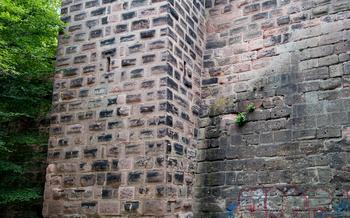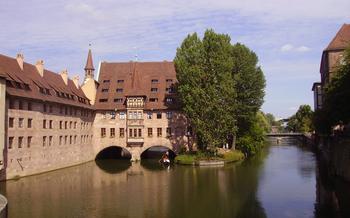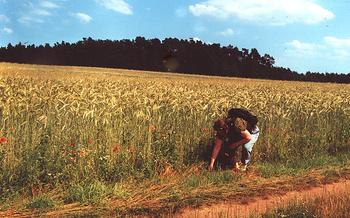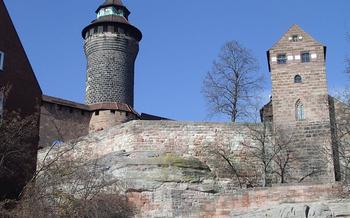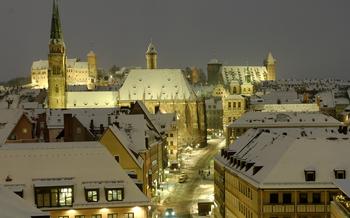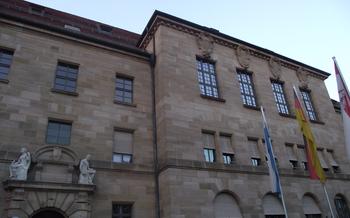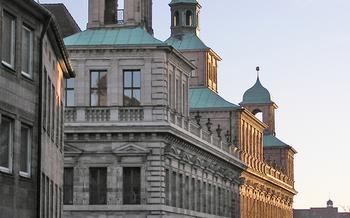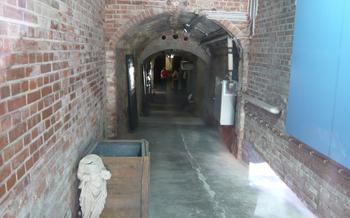
St. Lorenz Church (Lorenzkirche)
- History and Significance:
- Architectural Masterpiece:
- Interior Splendor
- Triumphant Organ
- Astronomical Clock
- Tomb of St. Sebald
- Nuremberg Trials and St. Lorenz Church
- Guided Tours
- Opening Hours and Admission
- Location and Accessibility:
- Photography and Videography
- Dress Code and Respect
- Events and Concerts:
- Nearby Attractions:
- Insider Tip:
History and Significance:
The grandeur of St. Lorenz Church, nestled amidst the heart of Nuremberg, Germany, invites you to embark on a journey through time. Its rich history dates back to the 13th century, when the original Romanesque structure stood as a testament to the city's growing religious significance. As Nuremberg flourished, so did the need for a grander edifice, leading to the construction of the current Gothic masterpiece in the 14th century.
St. Lorenz Church stands as one of the largest and most significant churches in Nuremberg, a symbol of the city's cultural and religious heritage. Its towering spires and intricate facade have borne witness to centuries of history, weaving together the threads of Nuremberg's past and present. Within its hallowed walls, the church has served as a beacon of faith, a sanctuary for contemplation, and a gathering place for the community, leaving an indelible mark on the city's spiritual and social fabric.
Architectural Masterpiece:
The Gothic architectural style of St. Lorenz Church is a testament to the skill and artistry of medieval craftsmen. Its imposing twin towers, reaching towards the sky, dominate the Nuremberg skyline. Intricate carvings adorn the exterior, depicting biblical scenes and mythical creatures, while flying buttresses provide structural support and add to the church's grandeur. The harmonious blend of architectural elements creates a sense of awe and wonder, leaving visitors in admiration of the architectural masterpiece that is St. Lorenz Church.
The interior of the church is equally impressive, with its soaring vaulted ceilings, elegant pillars, and intricate ribbed vaulting. The nave, with its rows of slender columns, leads the eye towards the chancel, where the high altar stands as a focal point. The intricate details and harmonious proportions of the interior create a space that is both sacred and serene, inviting contemplation and spiritual reflection.
St. Lorenz Church is a true testament to the enduring legacy of Gothic architecture. Its architectural features, both exterior and interior, showcase the ingenuity and artistry of medieval builders, making it a must-visit destination for anyone interested in architecture, history, or simply the beauty of sacred spaces.
Interior Splendor
The interior of St. Lorenz Church is an awe-inspiring testament to the skill and artistry of medieval craftsmen. Intricate stained glass windows adorn the walls, depicting biblical scenes and historical figures with breathtaking detail. The light filtering through the colorful glass creates a mystical ambiance that adds to the church's sacred atmosphere.
Impressive sculptures, altars, and artwork further enhance the interior's grandeur. The intricate carvings on the choir stalls, the delicate beauty of the stone sculptures, and the vibrant colors of the paintings create a harmonious ensemble that captivates the eye. Each piece of art tells a story, adding depth and meaning to the church's spiritual significance.
The most striking feature of the interior is undoubtedly the massive altar, a masterpiece of Gothic craftsmanship. The intricate carvings, delicate tracery, and shimmering gold leaf create a sense of awe and wonder. The altar serves as a focal point for worship, drawing the gaze of visitors and inviting them to contemplate the mysteries of faith.
St. Lorenz Church's interior is a testament to the enduring power of beauty and the enduring legacy of medieval artistry. It is a space that invites contemplation, reflection, and a profound connection with the divine.
Triumphant Organ
St. Lorenz Church is home to one of the largest and most renowned organs in the world. Built by the renowned organ builder Friedrich Heidenreich between 1474 and 1477, this magnificent instrument boasts an impressive history and significance in the world of organ music. With its 8000 pipes, 125 stops, and four manuals, the organ's sheer size and complexity are awe-inspiring.
The organ has undergone several renovations and expansions over the centuries, with the most significant restoration taking place in the early 19th century. Today, it stands as a testament to the skill and artistry of its creators, captivating audiences with its versatility, power, and grandeur.
Regular organ concerts are held in the church, showcasing the instrument's diverse range of sounds and capabilities. Renowned organists from around the world perform a variety of classical and contemporary pieces, filling the sacred space with enchanting melodies and harmonies. These concerts are a must-attend for music enthusiasts and anyone seeking a truly immersive musical experience.
Astronomical Clock
Within the hallowed halls of St. Lorenz Church, a marvel of medieval engineering awaits your discovery - the astronomical clock. This intricate timepiece, a testament to human ingenuity, has captivated visitors for centuries with its mesmerizing display of celestial movements.
As the clock's intricate mechanisms whir to life, the time, date, moon phases, and zodiac signs dance across its face, a symphony of precision and beauty. Intricate moving figures emerge from hidden nooks, enacting a celestial ballet that brings the cosmos to life before your very eyes.
Marvel at the skill and artistry of the clock's creators, who defied the limitations of their time to construct this mechanical masterpiece. Each rotating gear, each meticulously crafted figure, speaks to the boundless creativity and scientific prowess of the medieval era.
Tomb of St. Sebald
Within the hallowed walls of St. Lorenz Church lies the final resting place of St. Sebald, a revered figure deeply entwined with the history and identity of Nuremberg. St. Sebald, a missionary and hermit, is believed to have arrived in the city in the 8th century, dedicating his life to spreading Christianity and providing solace to the sick and needy. His profound influence on the community earned him widespread veneration, and after his death in 772, he was canonized as a saint.
The elaborate tomb of St. Sebald, crafted by the renowned sculptor Peter Vischer the Elder and his sons, stands as a testament to the saint's enduring legacy. Constructed between 1508 and 1519, the tomb is a masterpiece of Gothic art, showcasing intricate carvings, delicate tracery, and lifelike bronze figures. The centerpiece of the tomb is a reclining effigy of St. Sebald, depicted with a serene expression and hands clasped in prayer.
Surrounding the effigy are a host of apostles, saints, and biblical characters, each intricately detailed and contributing to the narrative of St. Sebald's life and teachings. The tomb's canopy, adorned with elaborate pinnacles and finials, further enhances its grandeur, creating a sense of awe and reverence.
The tomb of St. Sebald is not merely a work of art but also a symbol of the city's deep-rooted Christian faith and its enduring connection to its patron saint. Visitors to St. Lorenz Church are invited to pay their respects to St. Sebald and marvel at the exquisite craftsmanship that immortalizes his memory.
Nuremberg Trials and St. Lorenz Church
During the aftermath of World War II, Nuremberg, Germany, became the stage for a series of groundbreaking trials that would forever mark the course of international justice. St. Lorenz Church, a spiritual and architectural landmark of the city, played a significant role in this historic event.
The Nuremberg Trials, held from 1945 to 1946, were a series of military tribunals that prosecuted prominent Nazi leaders for war crimes, crimes against humanity, and crimes against peace. The trials sought to hold individuals accountable for the atrocities committed during the war and to establish a precedent for international criminal law.
St. Lorenz Church served as a venue for religious services and contemplation for the participants and observers of the trials. In the midst of the legal proceedings and the heavy burden of confronting the horrors of the past, the church provided a sanctuary for reflection and spiritual sustenance.
Beyond its practical role, St. Lorenz Church also held symbolic importance in the context of post-war reconciliation and justice. The church, with its rich history and cultural significance, represented the resilience and moral fortitude of the German people in the face of unimaginable darkness.
Its presence as a backdrop to the trials served as a reminder that even in the darkest of times, the pursuit of justice and the search for redemption were possible. St. Lorenz Church stood as a symbol of hope and renewal, signaling a new era of accountability and international cooperation in the pursuit of peace and human rights.
Guided Tours
To fully grasp the captivating history, intricate architecture, and profound significance of St. Lorenz Church, consider embarking on a guided tour. Knowledgeable guides bring the church's stories to life, offering insights into its construction, artistic treasures, and role in Nuremberg's past. Guided tours are conducted in various languages, ensuring that international visitors can also delve into the church's rich tapestry. These tours provide an immersive experience, allowing you to appreciate the church's details and ask questions to quench your curiosity. Embrace the opportunity to unlock the secrets of St. Lorenz Church with the guidance of an expert, making your visit an unforgettable journey through time and faith.
Opening Hours and Admission
St. Lorenz Church welcomes visitors throughout the week, offering ample opportunities to explore its grandeur. The church's opening hours are generally from 9:00 AM to 6:00 PM, allowing visitors to immerse themselves in its beauty during the daytime. However, it's essential to note that these hours may vary during special events or holidays, such as Christmas and Easter. To ensure the best possible experience, it's advisable to check the church's official website or contact the local tourist information center for the most up-to-date information.
Admission to St. Lorenz Church is free of charge, making it accessible to all visitors. This open-door policy reflects the church's commitment to sharing its cultural and spiritual heritage with the public. However, donations are gratefully accepted to support the church's ongoing maintenance and preservation efforts. Visitors are encouraged to contribute if they wish to help ensure that this magnificent landmark continues to thrive for generations to come.
Location and Accessibility:
St. Lorenz Church is conveniently located in the heart of Nuremberg's historic center, making it easily accessible on foot, by public transportation, or by car. The church stands proudly on Lorenzer Platz, surrounded by charming streets and historical buildings. Visitors can enjoy a leisurely stroll through the picturesque Old Town, admiring the medieval architecture and vibrant atmosphere, before arriving at the church's doorstep. Alternatively, Nuremberg's efficient public transportation system provides convenient access to St. Lorenz Church. Several bus and tram lines stop within walking distance, allowing visitors to hop off and explore the area at their leisure. For those arriving by car, there are designated parking garages nearby, ensuring a hassle-free visit. The proximity of St. Lorenz Church to other attractions, such as the Nuremberg Castle, the German National Museum, and the lively Hauptmarkt square, makes it an ideal starting point for a comprehensive exploration of the city's rich history and culture.
Photography and Videography
St. Lorenz Church welcomes visitors to capture the beauty of its interior and exterior through photography and videography. However, to maintain the sanctity of the church and respect the religious services held within, certain guidelines must be followed. Flash photography and tripods are not permitted inside the church to minimize distractions during services and to preserve the artwork and artifacts.
Discreet photography and videography are allowed using handheld devices without flash. Visitors are encouraged to capture the stunning stained glass windows, intricate carvings, and impressive architecture without disturbing the peaceful atmosphere of the church. To ensure the best photographic experience, visitors should consider the lighting conditions and avoid capturing images during services or when the church is crowded.
The church's exterior, with its imposing twin towers and intricate details, offers ample opportunities for capturing beautiful photographs. Visitors can stroll around the church, admiring its Gothic facade and the surrounding historic buildings. Respecting the privacy of others and avoiding blocking entrances or walkways is important when taking photographs or videos outside the church.
Dress Code and Respect
When visiting St. Lorenz Church, it is essential to dress appropriately, respecting its religious significance. Opt for modest attire that covers your shoulders and knees. Avoid wearing shorts, tank tops, or revealing clothing. While the church welcomes visitors from all backgrounds, maintaining a respectful demeanor is crucial. Please be mindful of others during services or prayers by keeping your voice low and avoiding disruptive behavior. Remember that St. Lorenz Church is an active place of worship, and visitors should act accordingly. Respect the sacred spaces and artifacts within the church, refraining from touching or interfering with them. By following these guidelines, you can contribute to a peaceful and reverent atmosphere for all visitors.
Events and Concerts:
St. Lorenz Church is not only a place of worship and historical significance but also a vibrant cultural venue. Throughout the year, the church hosts a variety of events and concerts that attract both locals and visitors. From classical music performances to organ recitals, there's something for everyone to enjoy.
To find out what's happening during your visit, check the church's website or contact the tourist information office. You can book tickets in advance to avoid disappointment, especially for popular events.
Attending a concert or event at St. Lorenz Church is a unique experience. The church's acoustics are renowned for their clarity and richness, making it an ideal venue for musical performances. The atmosphere is also special, with the church's beautiful interior providing a stunning backdrop for any event.
Whether you're a music lover or simply looking for a unique cultural experience, be sure to check out what's on offer at St. Lorenz Church during your visit to Nuremberg.
Nearby Attractions:
St. Lorenz Church is nestled in the heart of Nuremberg's historic center, surrounded by a wealth of cultural and historical attractions. Take a stroll through the city's charming streets to discover nearby gems such as the imposing Nuremberg Castle, a symbol of the city's rich past. Immerse yourself in the arts at the German National Museum, home to a vast collection of art and cultural artifacts from across Germany. Don't miss the lively Hauptmarkt square, the city's central hub, where you can soak in the vibrant atmosphere, admire the beautiful fountain, and savor local delicacies at the bustling market stalls. Nuremberg offers a captivating blend of history, culture, and entertainment, ensuring a memorable experience for every visitor.
Insider Tip:
Discover the serene courtyard, tucked away behind St. Lorenz Church, for a moment of tranquility. This hidden gem offers a unique perspective of the church's imposing architecture and intricate details. Stroll through the courtyard, admiring the well-manicured gardens and absorbing the peaceful ambiance. During the festive Christmas market season, the courtyard transforms into a magical winter wonderland, adorned with twinkling lights and charming wooden stalls. Be sure to visit St. Lorenz Church during this special time to experience its enchanting atmosphere and embrace the spirit of the season.
